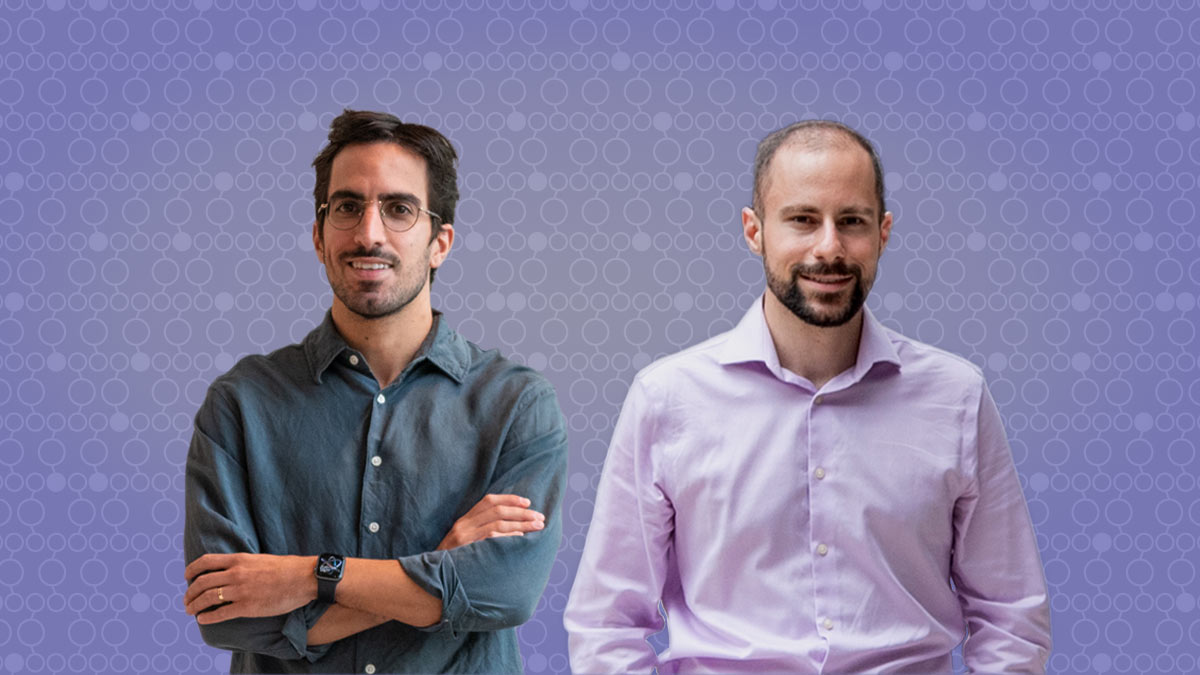Santiago Coelho, PhD, and Ilias Giannakopoulos, PhD, postdoctoral fellows at NYU Grossman School of Medicine and scientists with the Center for Advanced Imaging Innovation and Research at NYU Langone Health, have been named junior fellows of the International Society for Magnetic Resonance in Medicine (ISMRM). The ISMRM is the world’s largest organization of clinicians, researchers, and technologists dedicated to advancing MRI and comprises more than 8,000 members. Junior fellowship, awarded in 2025 to 16 members and announced at the society’s annual meeting held May 10-15 in Honolulu, recognizes “outstanding researchers and clinicians at an early stage in their careers, with an established and long-term commitment to ISMRM.”
“I am deeply grateful for this recognition from the scientific community that has shaped my growth as a scientist,” said Dr. Coelho. The honor “encourages me to continue pursuing science in the way that feels most meaningful to me: driven by curiosity, creativity, and collaboration,” he said.
Dr. Coelho’s research focuses on modeling the microstructure of living brain tissue with MRI. Although microstructure is too small to be visible on MR images, its properties can be probed indirectly by measuring diffusion—the natural, random motion of water molecules. Last year, his research proposal titled “Fast High-Resolution Microstructure Diffusion MRI Exploiting Data Redundancy” won a K99/R00 award from the National Institute of Biomedical Imaging and Bioengineering. According to the National Institutes of Health, K99/R00 grants, also known as pathway to independence awards, are indented “to facilitate a timely transition of outstanding postdoctoral researchers … from mentored, postdoctoral positions to independent, tenure-track or equivalent faculty positions.” Dr. Coelho’s mentors at NYU Langone are Els Fieremans, PhD, and Dmitry Novikov, PhD, who in 2024 were both named senior fellows of the ISMRM.
Discussing his proposal in a 2024 Lab Talk interview, Dr. Coelho explained the benefits of exploiting redundancies in diffusion encoding. “There are two directions you could go: one is that you could take a protocol that is currently too long to be clinically feasible and push it into a clinically-feasible timeframe; or you can take a protocol that is currently not feasible at all and create something reasonable for neuroscience research,” he said. “So, in principle, you could push both frontiers.”
Dr. Giannakopoulos, also named ISMRM junior fellow, said that being selected is a great honor. “It’s especially meaningful because it comes from an international community that sets the standard for MRI research,” he said. “It’s motivation to keep moving forward, especially at this transitional phase of my career … and it strengthens my engagement with the ISMRM community.”
Dr. Giannakopoulos investigates numerical methods for simulating the behavior of electromagnetic fields and estimating electrical properties of tissue. Such simulations are important at many stages of MRI development, including in the design of the radio frequency coils that are placed on the body during an MRI exam, in evaluations of MR safety, and in magnetic resonance electrical properties tomography, or MR-EPT, which is an area of active reserach. Like Dr. Coelho, Dr. Giannakopoulos is a recipient of a K99/R00 pathway-to-independence award from the NIBIB. His project focuses on the development of open-source software tools for rapid radio frequency coil modeling and simulation in MRI. His mentor at NYU Langone is Riccardo Lattanzi, PhD.
Interviewed in 2023 for the Lab Talk series, Dr. Giannakopoulos, discussed his award-winning work on matrix compression, the importance of electromagnetic modeling in ultra-high-field MRI, and the computational challenges for simulations at the 1-millimeter resolution of clinical images. “The matrix is a very big object. At five millimeters, maybe you can model it, but when you go to two or one, it’s almost impossible,” he explained. With a compression method developed by him and colleagues, “it’s down to a few megabytes from an original size of petabytes. And what this means is that … you can solve them much faster—in addition to being able to do them at all.”
Related Stories
Santiago Coelho, postdoctoral fellow who develops diffusion MRI methods for brain imaging, talks about modeling tissue properties, entering the field by chance, and what he proposes to do next.
Congratulations to Els Fieremans and Dmitry Novikov on being named among the 2024 senior fellows of the International Society for Magnetic Resonance in Medicine.
Ilias Giannakopoulos, postdoctoral fellow in MRI, talks about how electromagnetic waves interact with the body, why matrix compression matters, and where he finds inspiration.
Related Resources
A neural network for reconstructing electrical properties of materials and biological tissue from MRI data, plus synthetic phantoms.
Software for robust standard-model parameter estimation from diffusion MRI data.






